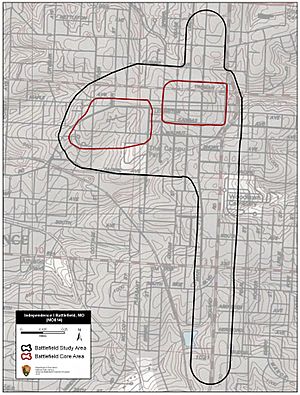First Battle of Independence facts for kids
Quick facts for kids First Battle of Independence |
|||||||
|---|---|---|---|---|---|---|---|
| Part of the Trans-Mississippi Theater of the American Civil War |
|||||||
 Independence Battlefield |
|||||||
|
|||||||
| Belligerents | |||||||
| Commanders and leaders | |||||||
| James T. Buel | John T. Hughes Gideon W. Thompson |
||||||
| Strength | |||||||
| 344 | 700-800 | ||||||
| Casualties and losses | |||||||
| ~344 | Unknown | ||||||
The First Battle of Independence was a small but important fight during the American Civil War. It happened on August 11, 1862, in Independence, Missouri. In this battle, the Confederate army won. This victory helped the Confederates control the Jackson County area for a few more days. It also allowed them to find more soldiers for their army.
It's important not to confuse this battle with the Second Battle of Independence. That battle took place later, in 1864, and was also a Confederate victory.
Contents
Why the Battle Happened
Confederate Plans
In the summer of 1862, the Confederate army needed more soldiers. They sent many recruiters from Arkansas into Missouri. These recruiters aimed to get more people to join the Confederate forces. Important leaders like Colonel John T. Hughes and Gideon W. Thompson were part of this effort.
Groups of fighters known as guerrillas and bushwhackers also helped. These were often small, independent groups. One famous leader was William Quantrill. For example, Upton Hays, another Confederate leader, had about 150 men. He was also helped by 30 men from Quantrill's group. More Confederate fighters kept arriving in the area.
Union Forces in Independence
Meanwhile, Union soldiers were staying in Independence, Missouri. Their leader was Lt. Col. James T. Buel. Independence had people who supported both the Union and the Confederacy.
Colonel Hughes and Gideon Thompson planned to cross the Missouri River. They wanted to recruit soldiers near Hughes's hometown. They joined Hays's camp with their men. They needed more ammunition and a victory to help their recruiting. So, they decided to surprise attack Buel's Union forces. Cole Younger helped by secretly checking out the town the day before the attack.
Warnings Ignored
Lt. Col. Buel had sent one of his officers, Captain Breckenridge, to scout for eleven days. But Breckenridge found nothing. However, Buel did learn about Hays's camp and planned to attack it.
On the evening of August 10, some citizens warned Buel about an attack on the city. Many Union supporters had already left. But Buel did not listen to these warnings. Another officer, Captain Rodewald, did take the warnings seriously.
The Union soldiers were set up in three main spots. These were their camp near a rock wall, the bank building where Buel had his headquarters, and the county jail.
Who Fought in the Battle
Union Side
- Lt. Col. James T. Buel
- 7th Missouri Volunteer Cavalry (parts of companies B & D)
- 2nd Battalion Missouri State Militia Cavalry (parts of companies B, D, & E)
- 6th Regiment Missouri Enrolled Militia (1 company)
Confederate Side
- Col./Acting Brigadier John T. Hughes
- Hughes' Recruiters
- Hays' Regiment
- Quantrill's Guerrillas
The Battle Begins
Colonel John T. Hughes's Confederate force attacked Independence before dawn. They moved in two groups using different roads. They rode through the town to the Union camp. There, they fired at the sleeping Union soldiers.
Captain Breckenridge suggested that the Union soldiers should give up. But Captain Jacob Axline quickly got the Union troops behind a rock wall and a ditch. The Confederates searched the Union camp for ammunition. The Confederates attacked Axline's wall many times. But they could not take it. During these attacks, Colonel Hughes was killed. Thompson and Hays were wounded.
Lt. Col. Buel tried to defend himself with some of his men. They were in the bank building he used as his headquarters. But he was forced to surrender. This happened after a building next to the bank was set on fire. Buel then met with the new Confederate commander, Col. Gideon W. Thompson. Thompson had taken over after Colonel Hughes was killed. Buel surrendered, and about 150 of his men were allowed to leave. The rest had either escaped, hidden, or were killed.
After the Battle
Casualties and Losses
The First Battle of Independence caused about 344 known Union losses. We do not know the total number of Confederate losses.
Most of the Union soldiers in Independence were captured. Only a few groups managed to escape. The Confederate victory was costly for them, though. Ten experienced officers died, including Colonel John T. Hughes. Colonels Hays and Thompson were also wounded. The Confederate winners left town later that afternoon. But they stayed in the area for several days. Hays then led them in another attack with other Confederate groups. This attack was against Union forces at Lone Jack.
What Happened Next
Even though the Confederates won at Independence, they could not use this victory for much more. Confederate control in the Jackson County area continued for a short time.
Lt. Col. Buel was criticized for how he handled the battle. He did not listen to the warnings from citizens. Captain Breckenridge was also criticized for not finding any guerrillas before the battle. He was also too quick to surrender. Both officers faced a military trial. The soldiers who were captured were removed from service. Since the officers were dismissed with their men, nothing more came from the trials.
On June 3, 1864, Captain Axline was killed by guerrillas. This happened while he was on his way home to Hickman Mills.
Independence later became the site of a second Civil War battle. This happened in October 1864. It was part of General Sterling Price's Missouri Campaign. That campaign ended with his defeat at the Battle of Westport.
Images for kids


